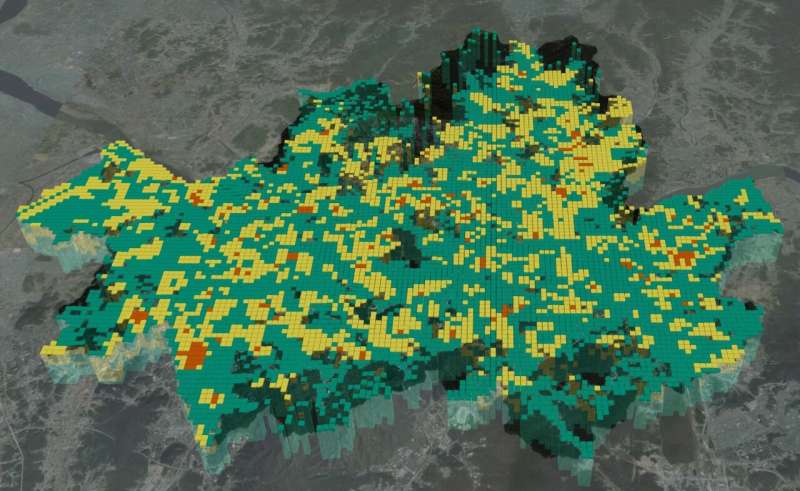This article has been reviewed according to Science X's editorial process and policies. Editors have highlighted the following attributes while ensuring the content's credibility:
fact-checked
proofread
Developing a 3D liquefaction hazard map

Korea Institute of Civil Engineering and Building Technology has successfully developed a "three-dimensional liquefaction hazard map" that visually presents ground liquefaction forecasts in the event of an earthquake.
Liquefaction is a phenomenon in which the ground surface loses its stiffness and acts like a liquid due to the repeated application of large forces generated by an earthquake. It can cause buildings or other structures to tilt or collapse, taking a heavy toll in terms of lives and property.
The phenomenon, which became widely known after the 1964 Niigata and Alaska earthquakes, wreaked havoc across a broader range of ground in the 2011 Christchurch and Great East Japan earthquakes. So far, liquefaction-related damage has been frequently reported around the world.
A research team (Dr. Han, Jin-Tae, Dr. Kim, Jongkwan) at KICT's Department of Geotechnical Engineering Research developed a 3D liquefaction hazard map that is connected to Korea's geotechnical information portal, a database system for ground data. The map displays liquefaction risks by region in 3D upon the occurrence of an earthquake.
Ground made up of soil tends to maintain its solid state up until becoming more liquid-like in the process of liquefaction, which is known as liquefaction resistance. Liquefaction resistance varies in different regions to each region's distinct soil composition.
The research team calculated the factor of safety against liquefaction by comparing the forces applied to the ground generated by an earthquake and the soil's resistance to liquefaction. For the calculation of regional liquefaction resistance, the team used the database of the geotechnical information portal built by KICT. It then rendered the 3D liquefaction hazard map by visualizing the safety factors by ground depth.
Typically, 2D liquefaction hazard maps are created because most structures are built on the ground surface. However, such maps are not sufficient in places like Korea that make the most of underground space due to limited land, as they are unable to accurately identify risks underground. However, the 3D map can determine the risks in underground spaces as well as those on the ground.
The research team also improved the existing spatial interpolation method to apply it to the 3D map. Spatial interpolation is the process of estimating the values at unknown points by using points with known values.
KICT integrated the 3D liquefaction hazard map with S-Map OpenLab, the spatial data platform of the Seoul Metropolitan Government. S-Map is a 3D virtual reality version of Seoul that was designed to help establish policies in various areas including safety, environment and city planning and solve urban issues. The integration of the 3D liquefaction map and S-Map is expected to enable the monitoring of risks to structures not only in underground spaces but also on the ground.
Dr. Han, Jin-Tae, who led the research, said, "The 3D liquefaction hazard map in connection with the national geotechnical information portal system is expected to advance the related technology because the map includes 3D ground data for the safe management of underground spaces. The integration of the map with Seoul's S-Map will serve as a model that can be applied to a variety of related areas."
The work is published in the journal Applied Sciences.
More information: Jongkwan Kim et al, Improved IDW Interpolation Application Using 3D Search Neighborhoods: Borehole Data-Based Seismic Liquefaction Hazard Assessment and Mapping, Applied Sciences (2022). DOI: 10.3390/app122211652
Provided by National Research Council of Science & Technology



















